Watamu Community And Conservation Efforts
Date published: 25/10/2018
Date published: 25/10/2018
Watamu is a wonderful surprise to any new visitor; once a sleeping fishing village in the 1970’s it is now a bustling hive of industry, grown up from tourism. Watamu is a delightful combination of old Swahili culture, ancient coastal forest, intricate mangrove forests and tributaries and an ocean with fringing reefs, islands and beaches stretching as far as the eye can see.
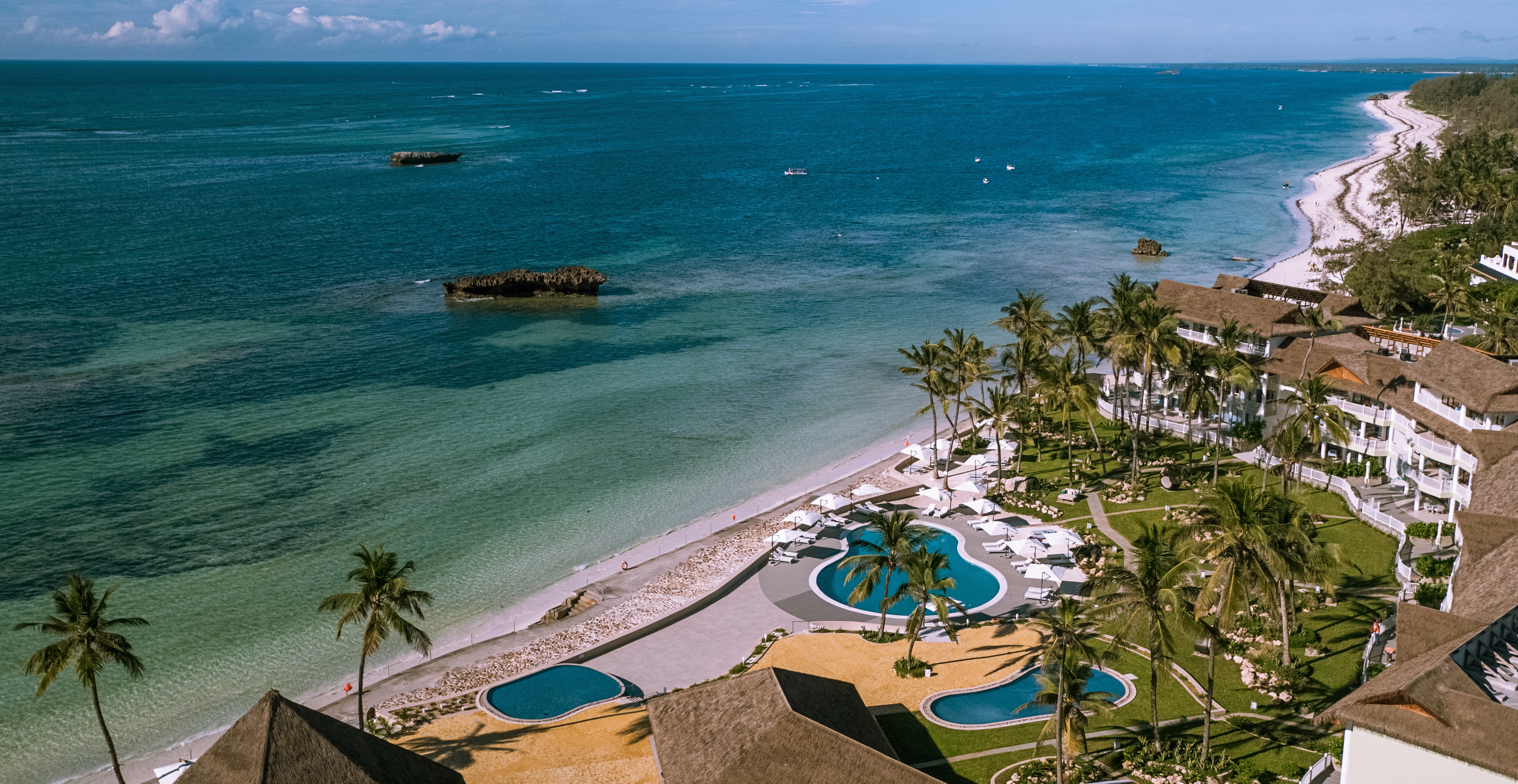
Watamu Beach with turquoise blue waters
Watamu means ‘Home of the Sweet People” in Swahili. After 14 years of living here, for me Watamu people are so much more – industrious, creative, and inspiring. Watamu people comprise of mainly two tribes; the Bajun sea-faring people and the Giriama, farmers, who often have very different outlooks on life, but when faced with a problem the only way forward for both is to find a solution. I was introduced to this philosophy by a friend called Kahindi: “There is never a problem that cannot be solved”.
Returning to paradise, it comes as no surprise that it is under threat all over the world because of humans; plastic pollution washes up from other countries, riding on oceanic currents called gyres from as far away as Indonesia and India. It also chokes our own Kenyan rivers, and travelling down from landfills in Nairobi and other up-country sources, to end up in the Indian Ocean and washing into our pristine beaches on the tide. What do Watamu people start to do? Solve the problem, of course!
For years everyone has been cleaning the beaches of Watamu. Originally collecting wacky and weird shaped driftwood, perhaps part of an old dhow, or canoe if you were lucky. In recent times, however, pollution has been the norm and increasing at an alarming rate. Beach clean-ups have become more regular with everyone spilling on to the beach to help. Organised by the uniformed Kenya Wildlife Service – custodians of the oldest Marine Park in Kenya and protectors of our marine life – they are joined by school children, hotels, businesses, local people, conservation organisations…., just about everyone takes part and it gives a real sense of unification to our village. But the next problem left us scratching our heads, what are we going to do with the trash?
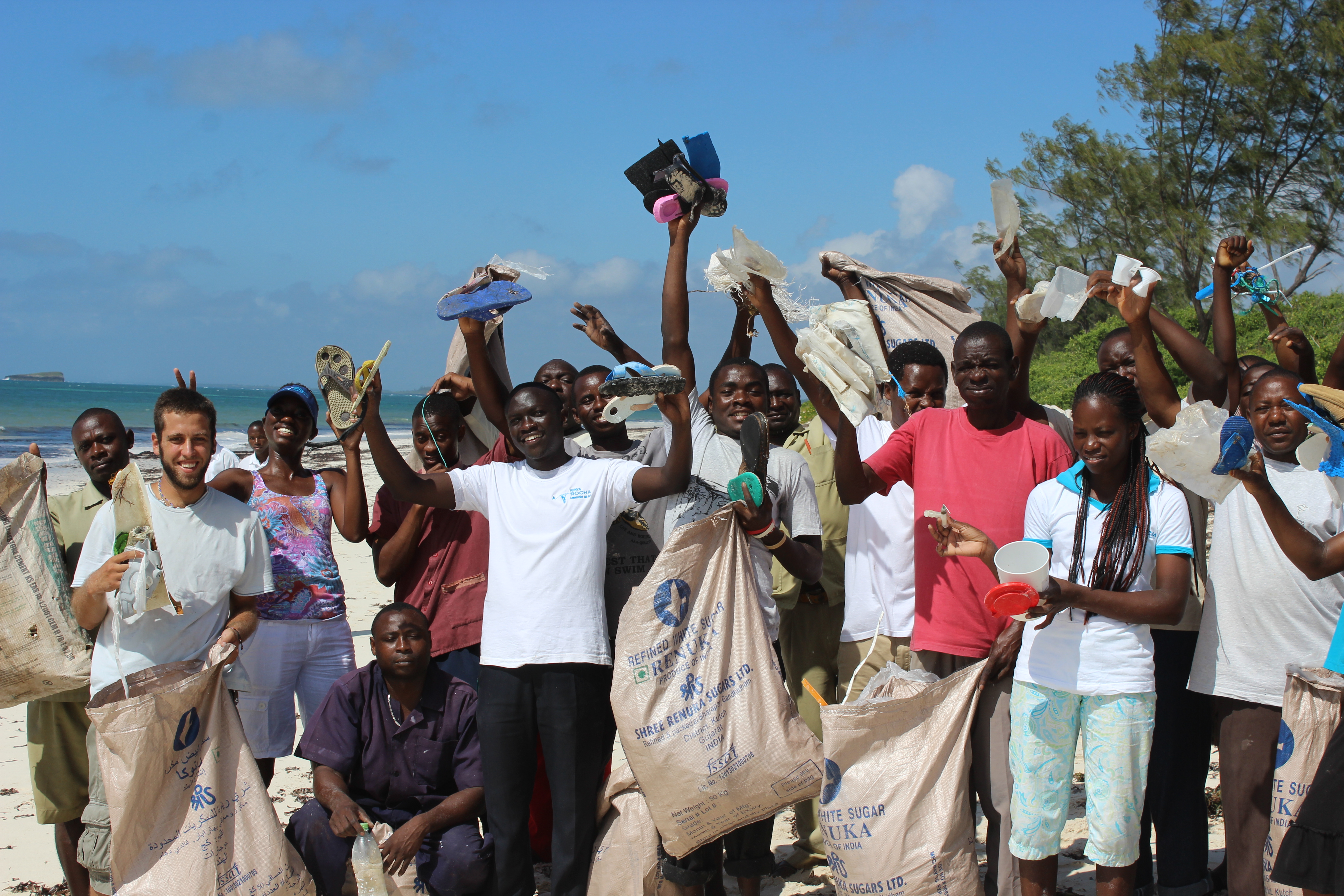
Team cleaning up the beach
Watamu Marine Association, which brings people together to brainstorm conservation issues and find solutions, tackled the pollution and recycling problem head on. Together with businesses and hotels such as Hemingways Watamu and community leaders, the concept of EcoWorld Watamu was conceived. Based in the heart of Dabaso, a satellite fishing village beside Mida Creek, this unique facility has grown. It is a trash recycling centre that has captured everyone’s imagination. Supported originally by the African Fund for Endangered Wildlife – Giraffe Center, the generosity of people and organisations supporting EcoWorld knows no bounds when “Turning the Tide on Trash”.
The original idea for EcoWorld was to help encourage travellers to explore outside their hotels and homes and venture into the local communities to experience the ‘real’ Watamu. Taking a right turn off road by Turtle Bay Beach Club, you experience an adventure even before you have arrived at your destination. Bumping along a rough track past local mud and wattle homesteads, surrounded by cheery waving families, we pass forests of palm, cashew and mango trees, until you arrive 2kms later at a prominent sign, not surprisingly made from trash, ‘Welcome to EcoWorld”. Here a vivacious Myra greets us, manager and marine litter artist, with promises that we will be amazed.
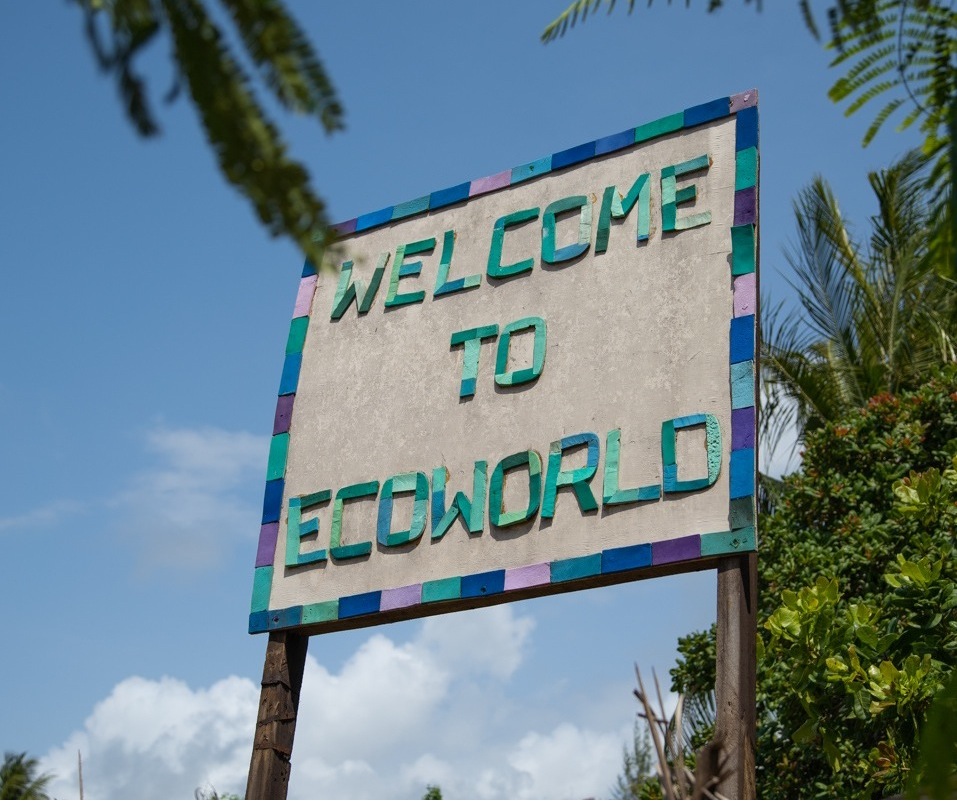
Welcome to Ecoworld Sign Board
First off we are shocked, and appalled. We are led into a field filled with literally mountains of waste, plastic bottles, glass bottles (lots of wine bottles – Watamu people sure drink a lot!) broken containers, rope and flip flops, (no plastic bags, they are banned in Kenya!). The list of trash is endless, collected from beach clean-ups, hotel waste, resident’s waste from local houses and businesses.
We are left thinking why on earth would anyone want to visit this depressing place?
Then we turn a corner and in the sunshine stands a glittering complex of buildings; this is EcoWorld. The recycling centre is created from an amazing combination of glass and plastic bottles. Our instant reaction is to run up and touch them, thinking my home/house/office would look great if built like this, and it would solve the trash problem. And this is exactly what EcoWorld wants you to think, as it is a green demo site for energy saving, alternative bio energy ideas, recycling, permaculture, marine litter art installations, health matters and all supporting the community with small cottage industries.
Myra shows us the 3-metre-long “Bottlenose Dolphin” made from 1,000 glass wine bottles, created by Andrew McNaughton, beach artist and sculptor, which makes up part of a wall. She explains the why and the conservation importance of all the work going on here, and importantly how this benefits the local community financially. We see the plastic crushing machine which turns trash in to colourful tiny pieces and made into art, or sold on to commercial companies who make furniture. We marvel at art and crafts made from trash by local people for cash. Myra is a professional artist and exhibits her work with Andrew. It is very difficult to believe that trash can be transformed into such beautiful pieces.
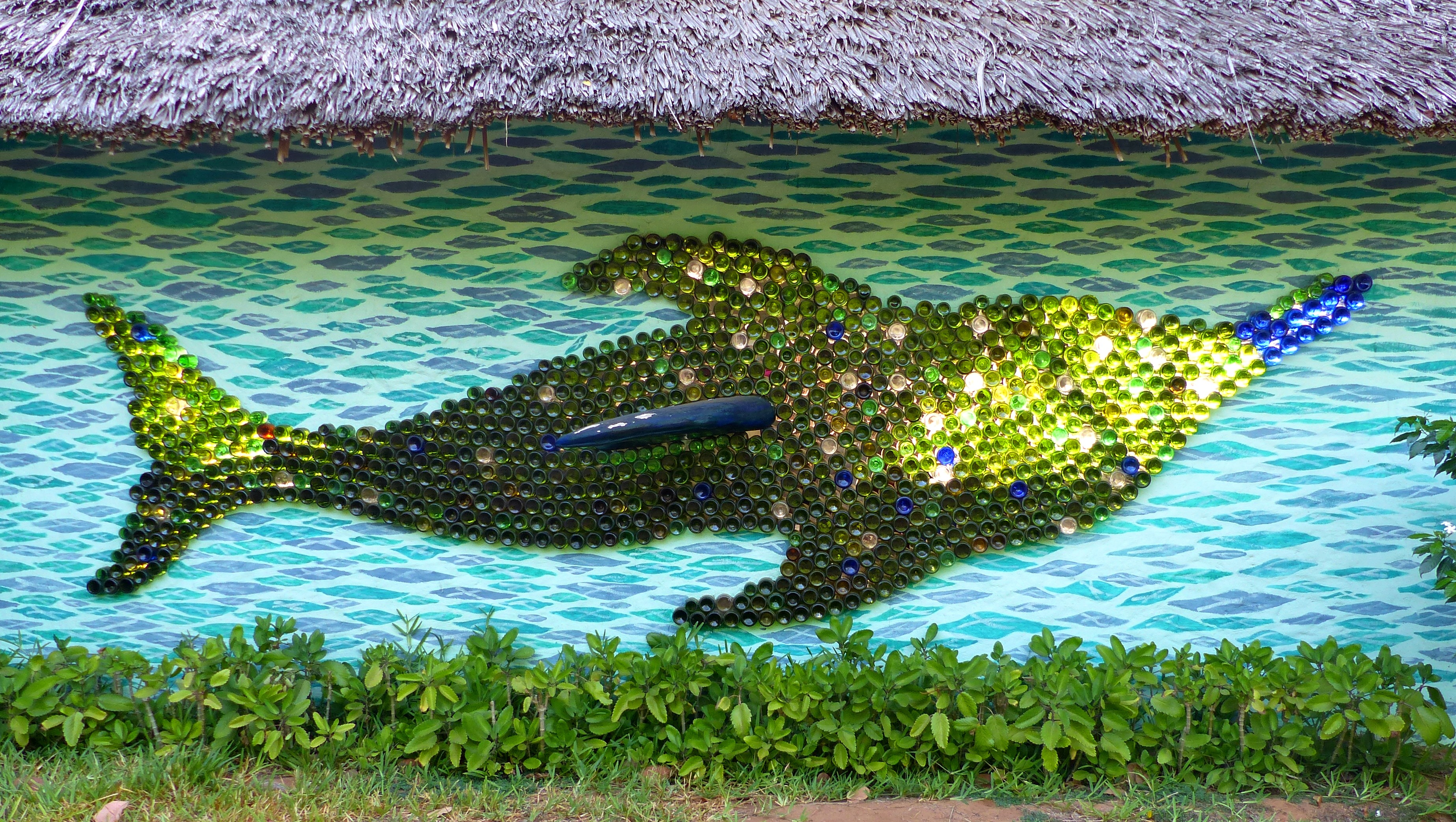
Bottlenose Dolphin made from 1,000 glass wine bottles
EcoWorld is not only about recycling. Dabaso Tujengane (Support One Another) and Sauti Ya Wanawake (Voice of Women) are two community groups that make natural soaps, oils from medicinal plants and virgin coconut oil that guests can help participate in producing. At the end of the tour we enter an Aladdin’s Cave shop selling recycled, eco and “green” products, proving that trash is cash for the Watamu people.

Products made from recycled waste
Moving on from EcoWorld but still in Dabaso, we head off to Sita Snake Park. Not to be confused with Bio-Ken Snake Farm the other end of town, which does amazing work creating anti venom to help victims of snake bites. Jackson, the manager of Sita Snake Park, was taught by the founders of Bio -Ken, James Ashe and his wife Sanda sharing their love of snakes. Not all people are big fans of snakes, and especially in Kenya, but Jackson gently persuades visitors that most snakes are friends not foe and are all part of a very cleverly balanced eco system. Many snakes are not venomous, and most snakes will not attack, unless they are approached or threatened and only in defence. Some are not convinced, of course, but those who are brave enough can handle the rufous beaked snake, a very pretty reptile that winds its length around your wrist like a bracelet. We peer cautiously at the black mamba safely in his enclosure; he is actually grey in colour and has an inky black mouth. He is very venomous, but we are again reminded by Jackson that these snakes will not attack unless provoked. Moving on quickly even the most worried of us decide to “wear” the python around our necks. This impressive snake can be as long as 23 metres, but our python is only 7 metres, thankfully! The snake park is a great place to visit, with 14 exhibits and Jackson who genuinely cares for his reptiles.
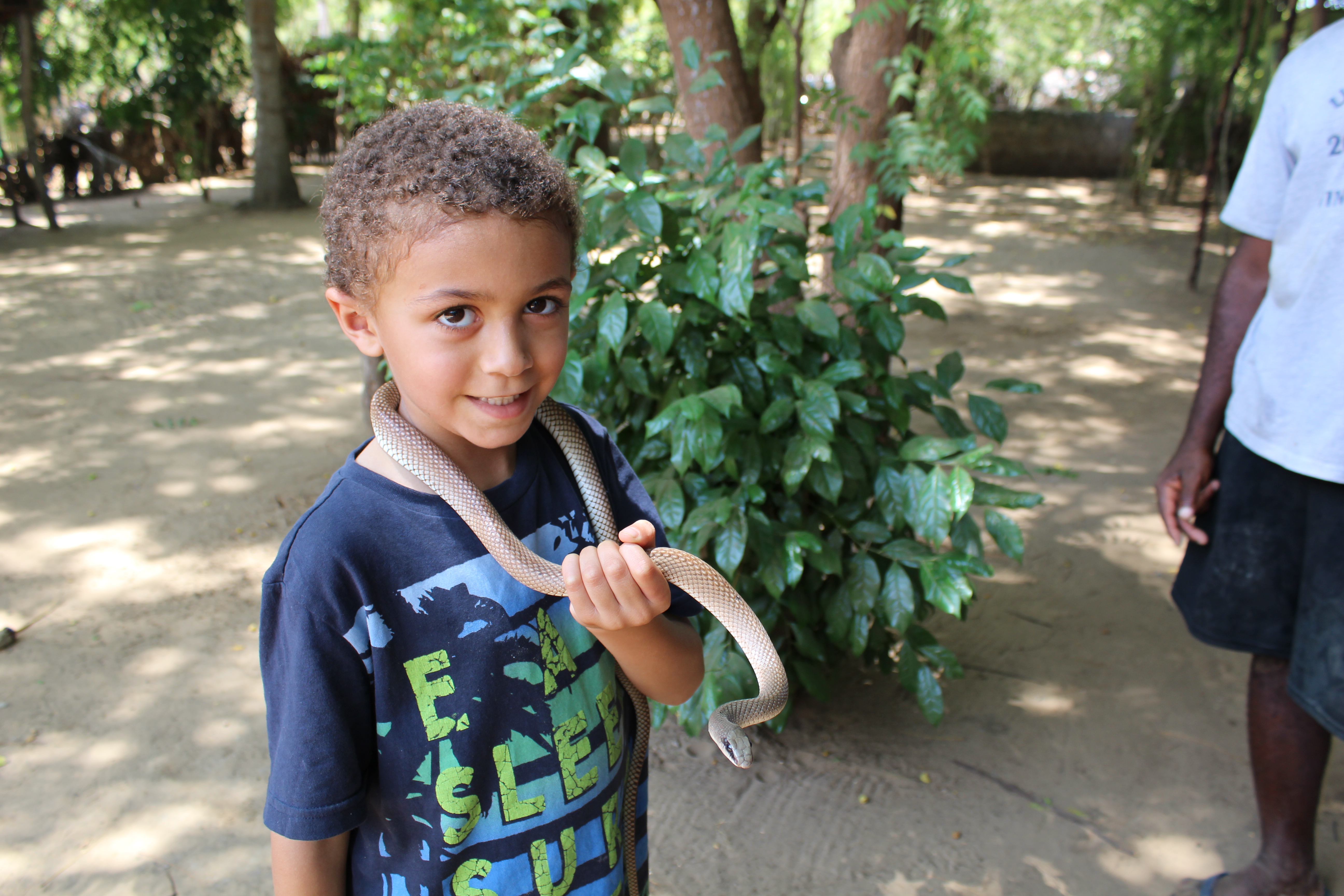
A brave boy with a snake at the Sita Snake Park
But we leave to go to our final destination at Mida Creek.
If there is one single community success story in Dabaso Watamu, it is the Crab Shack. Built originally as an access boardwalk through the mangroves to Dabaso Conservation Group’s mud crab fattening cages, the concept has blossomed as a successful bar and restaurant run entirely by the community with profits going to conserving the creek’s wildlife and mangroves. As the sun is beginning to set, we head out on a man powered local dugout canoe to peacefully meander through the mangrove
forests. It is a bird watchers paradise here, and as part of the protected Marine Reserve is a designated ‘Important Bird Area,’ home to over 70 endemic and migratory bird species. We spot the local crab plover, an array of king fishers, carmine bee eaters, and most spectacularly flamingos. As we silently glided past, not disturbing the birds feeding or roosting, the sun is setting over the creek. This is a sight that is quite unique to Watamu and one of the few places to watch the day end in all its glory.
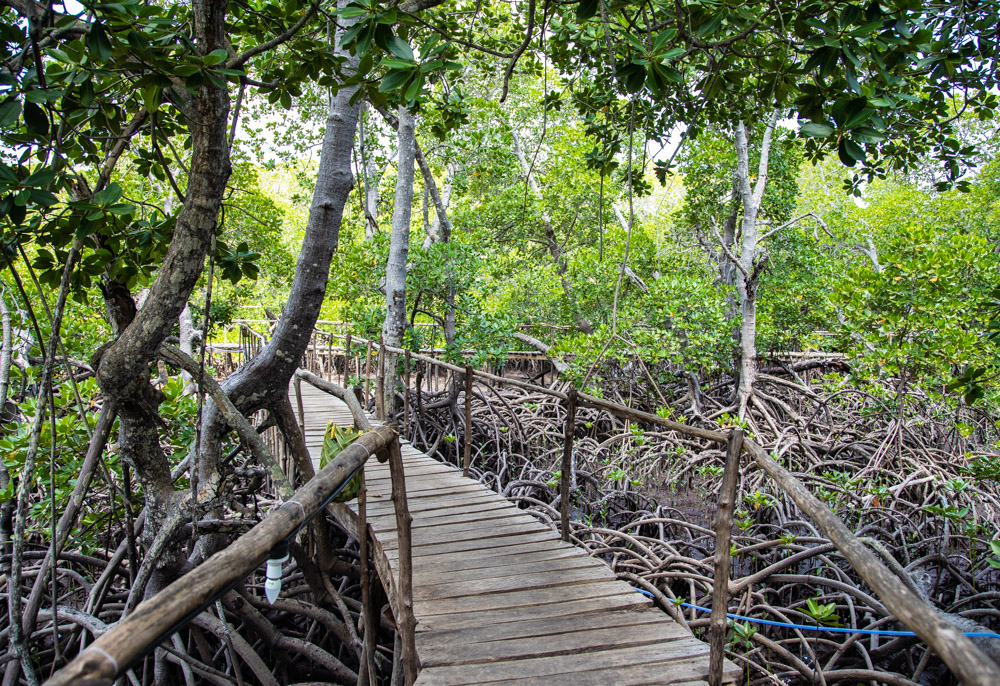
Boardwalk through the mangroves to Crab Shack
Back on land we head to the Crab Shack for sun downer beers and their famous signature crab samosas, which are melt-in-the-mouth incredible with a squeeze of fresh lime. Main dishes are fresh fish, of course crab, lobster and creek oysters.
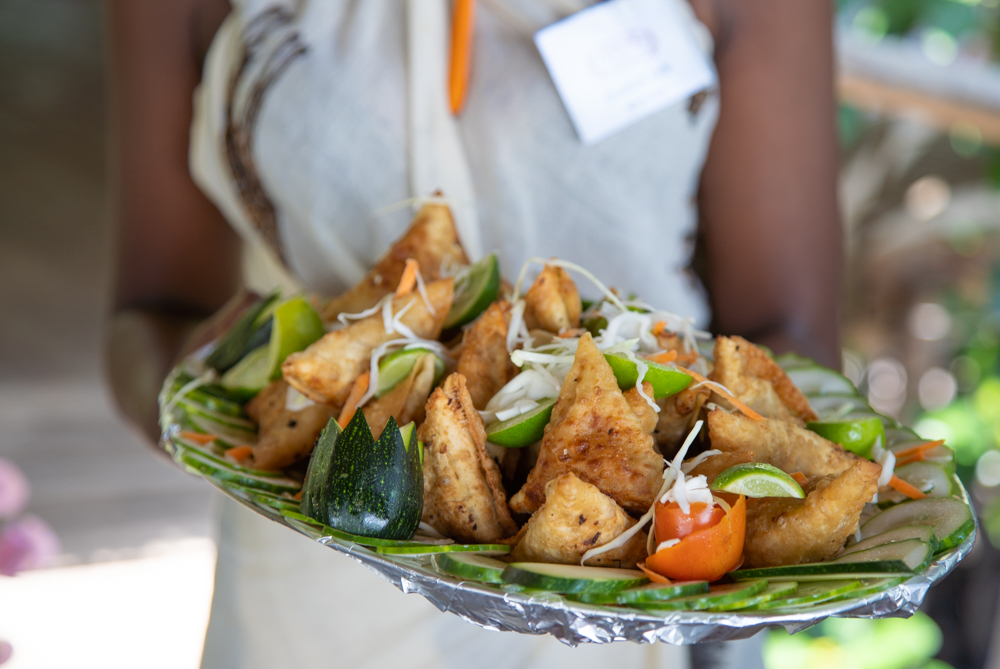
Crab Samosas at crab Shack Dabaso
All dishes are simple but prepared in a local style with fresh ingredients and are enjoyed to the sound of the creek in the dusk as night settles. Guests talk of the whole experience being zen-like and serene, a place where they can unwind gently to the sound of nature in this very special part of Watamu.